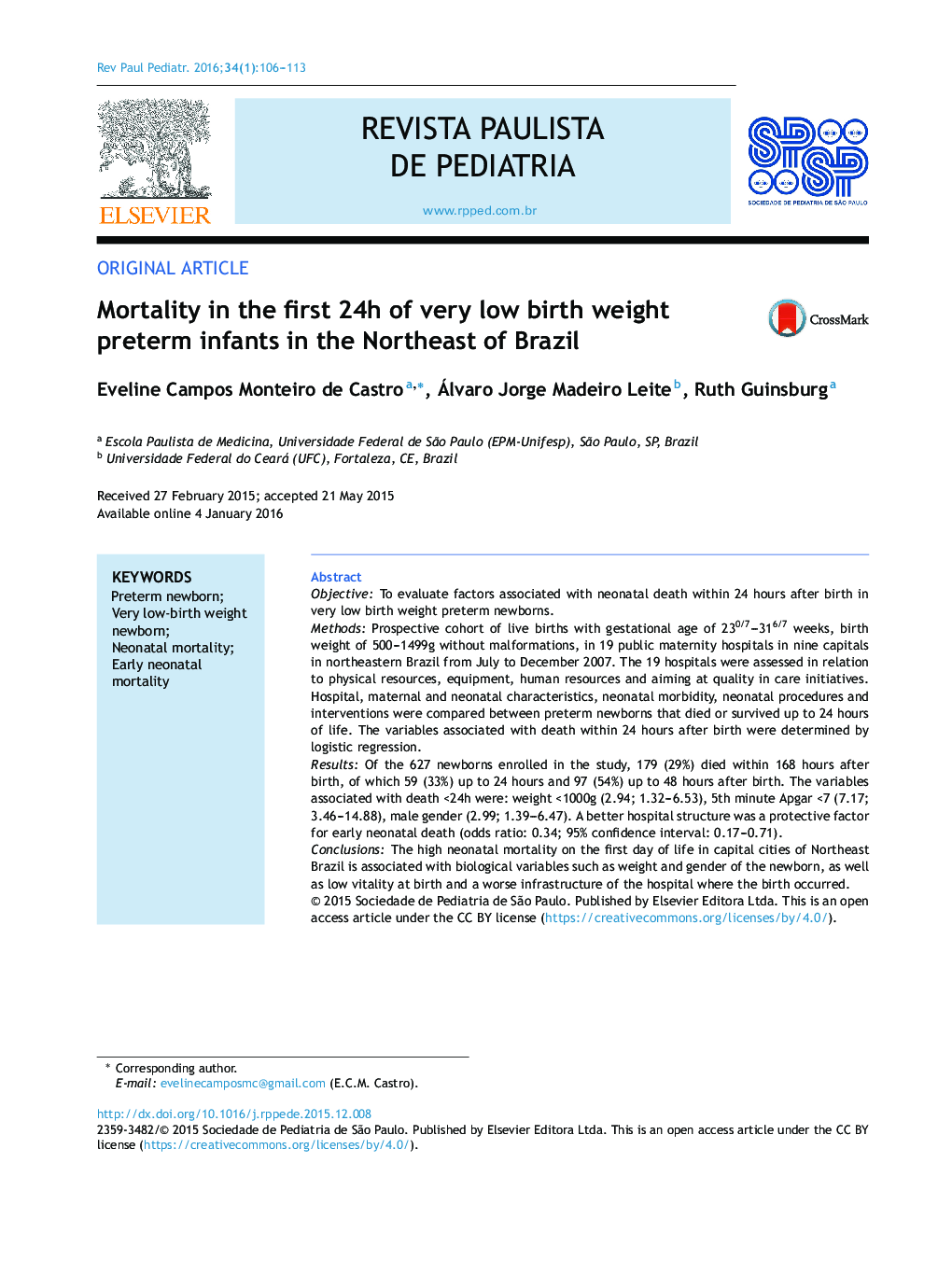| کد مقاله | کد نشریه | سال انتشار | مقاله انگلیسی | نسخه تمام متن |
|---|---|---|---|---|
| 4176181 | 1276237 | 2016 | 8 صفحه PDF | دانلود رایگان |
ObjectiveTo evaluate factors associated with neonatal death within 24 hours after birth in very low birth weight preterm newborns.MethodsProspective cohort of live births with gestational age of 230/7–316/7 weeks, birth weight of 500–1499g without malformations, in 19 public maternity hospitals in nine capitals in northeastern Brazil from July to December 2007. The 19 hospitals were assessed in relation to physical resources, equipment, human resources and aiming at quality in care initiatives. Hospital, maternal and neonatal characteristics, neonatal morbidity, neonatal procedures and interventions were compared between preterm newborns that died or survived up to 24 hours of life. The variables associated with death within 24 hours after birth were determined by logistic regression.ResultsOf the 627 newborns enrolled in the study, 179 (29%) died within 168 hours after birth, of which 59 (33%) up to 24 hours and 97 (54%) up to 48 hours after birth. The variables associated with death <24h were: weight <1000g (2.94; 1.32–6.53), 5th minute Apgar <7 (7.17; 3.46–14.88), male gender (2.99; 1.39–6.47). A better hospital structure was a protective factor for early neonatal death (odds ratio: 0.34; 95% confidence interval: 0.17–0.71).ConclusionsThe high neonatal mortality on the first day of life in capital cities of Northeast Brazil is associated with biological variables such as weight and gender of the newborn, as well as low vitality at birth and a worse infrastructure of the hospital where the birth occurred.
ResumoObjetivoAvaliar os fatores associados ao óbito neonatal até 24 horas após o nascimento de recém-nascidos pré-termo de muito baixo peso.MétodosCoorte prospectiva dos nascidos vivos com idade gestacional de 230/7–316/7 semanas, peso ao nascer de 500–1.499g sem malformações em 19 maternidades públicas de nove capitais na Região Nordeste do Brasil de julho a dezembro de 2007. Os 19 hospitais foram avaliados com relação aos recursos físicos, equipamentos, recursos humanos e iniciativas de busca de qualidade no atendimento. As características hospitalares, maternas e neonatais, a morbidade neonatal, os procedimentos e as intervenções neonatais foram comparados entre os recém-nascidos pré-termo que morreram ou sobreviveram até 24 horas. As variáveis associadas ao óbito até 24 horas após o nascimento foram determinadas por regressão logística.ResultadosDos 627 recém-nascidos incluídos no estudo, 179 (29%) morreram até 168 horas de vida, dos quais 59 (33%) até 24 horas e 97 (54%) até 48 horas. As variáveis associadas ao óbito <24h foram: peso <1.000g (2,94; 1,32–6,53), Apgar 5° minuto <7 (7,17; 3,46–14,88), sexo masculino (2,99; 1,39–6,47). A melhor estrutura hospitalar foi fator de proteção para o óbito neonatal precoce (Odds Ratio 0,34; Intervalo de Confiança 95% 0,17–0,71).ConclusõesA elevada mortalidade neonatal no primeiro dia de vida nas capitais do Nordeste brasileiro associa-se a variáveis biológicas, como o peso e o sexo do recém-nascido, assim como à baixa vitalidade ao nascer e à pior infraestrutura do hospital no qual o parto ocorreu.
Journal: Revista Paulista de Pediatria (English Edition) - Volume 34, Issue 1, March 2016, Pages 106–113
